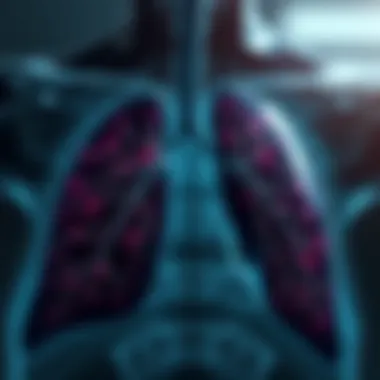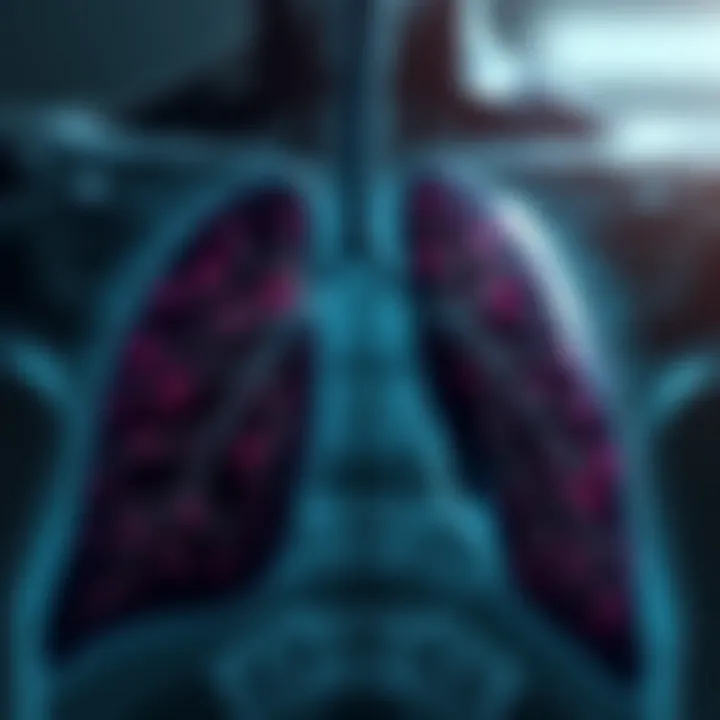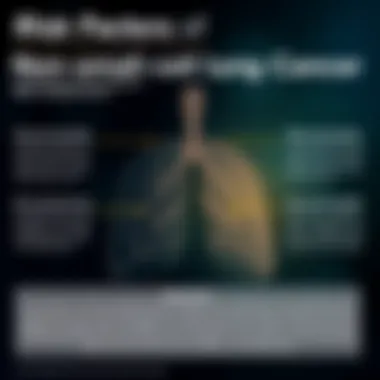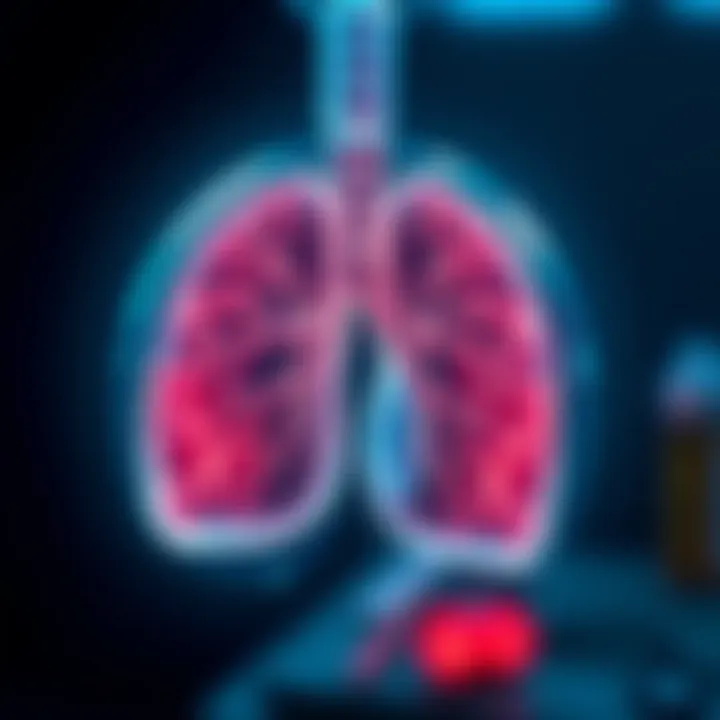Understanding Non-Small Cell Lung Cancer: A Detailed Overview


Intro
Non-small cell lung cancer (NSCLC) is a term that encompasses a variety of lung cancers, which in turn represents the majority of all lung cancer cases diagnosed annually. The sheer volume of diagnoses, along with a rapidly evolving landscape of treatment options and ongoing research, underscores the need for a clear understanding of the complexities surrounding this disease. With the incidences of NSCLC on the rise around the world, grasping its intricacies becomes a pivotal task for students, researchers, educators, and health professionals alike.
In the following sections, we will explore critical aspects of NSCLC, starting with foundational concepts. This discussion will lay the groundwork for subsequent analyses of current research trends and treatment modalities.
Key Concepts
Definition of the Main Idea
NSCLC is a broader classification of lung cancer that primarily includes two major subtypes: adenocarcinoma and squamous cell carcinoma. Unlike small cell lung cancer, which is often more aggressive, NSCLC typically progresses more gradually. Understanding these distinctions is crucial for diagnosis and treatment.
Overview of Scientific Principles
At its core, NSCLC involves abnormal cell growth in lung tissue. These cells may originate from different types of lung cells, leading to various subtypes. The common element in all forms of lung cancer is the uncontrolled division of cells, which can form tumors and spread to other parts of the body if left unchecked.
One of the significant challenges in tackling NSCLC lies in tumor heterogeneity, which refers to the presence of various cell populations within a tumor. Such diversity can alter treatment responses, making personalized medicine an essential consideration. Various factors contribute to the risk of developing NSCLC, including genetic predispositions and environmental irritants such as smoking and pollution.
"Understanding the biology could lead to better strategies in both preventing and treating NSCLC."
"Understanding the biology could lead to better strategies in both preventing and treating NSCLC."
Current Research Trends
Recent Studies and Findings
The research landscape surrounding NSCLC is rich with ongoing studies. Recently, advancements in personalized medicine have gained traction. For example, targeted therapies such as erlotinib and crizotinib have shown promise in treating specific genetic mutations common in some NSCLC patients. These developments are leveraging genomic profiling to tailor treatments.
Significant Breakthroughs in the Field
A noteworthy breakthrough is the integration of immunotherapy, which harnesses the body’s immune system to combat cancer cells. Agents like pembrolizumab, which targets PD-1 pathways, have transformed the treatment options available, offering hope to patients with advanced disease. Research is also shifting towards combination therapies, where immunotherapy is used alongside traditional chemotherapy to enhance treatment efficacy.
The relevance of these findings cannot be overstated, as they represent a paradigm shift in how we approach NSCLC treatment. Keeping abreast of these developments not only aids professionals in providing the best care but also positions researchers at the forefront of the fight against cancer.
For further reading and resources on NSCLC, consider exploring:
Through rigorous study and exploration of emerging trends, the complexity of NSCLC begins to untangle, revealing a path toward more effective management and treatment outcomes.
Defining Non-Small Cell Lung Cancer
Understanding Non-Small Cell Lung Cancer (NSCLC) is pivotal for grasping not only the nuances of lung cancer but also its broader implications in oncology. NSCLC, accounting for nearly 85% of lung cancer cases, stands as a significant concern due to its various subtypes and treatment complexities. This foundation sets the stage for a more detailed exploration of its variants, diagnosis, and treatment avenues.
The diagnosis of NSCLC can often be a journey riddled with confusion and misunderstanding. It’s not merely about identifying the disease; it’s also about understanding the specific type of cancer, treatment responses, and prognostic markers associated with it. Knowing the distinctions can lead to better-informed decisions regarding management strategies and outcomes.
Moreover, comprehending the broader context of lung cancer types—specifically NSCLC versus small cell lung cancer (SCLC)—is essential for both patients and healthcare providers alike. By defining these terms clearly, we lay a groundwork of knowledge that aids in recognizing symptoms, advocating for appropriate treatments, and staying updated with ongoing research advancements.
Basic Definitions and Terminology
Diving deeper into the crux of non-small cell lung cancer, the terminology used in this field is crucial. NSCLC is typically subcategorized into three primary types: adenocarcinoma, squamous cell carcinoma, and large cell carcinoma. Each of these types comes with its own set of behavior, treatment modalities, and prognosis.
- Adenocarcinoma: This is the most prevalent form among NSCLC types, often found in the outer regions of the lungs. It’s more common in non-smokers compared to the other types.
- Squamous cell carcinoma: This type is often linked with a history of smoking and usually occurs in the central parts of the lungs, particularly around the bronchi.
- Large cell carcinoma: As the name implies, this variant is characterized by large, abnormal-looking cells. It often grows and spreads quickly, making it more challenging to treat.
Grasping these terms helps in understanding the overall landscape of lung cancer and emphasizes the importance of individualizing treatment plans based on the specific type of NSCLC diagnosed.
Classification of Lung Cancer Types
An initial glance at lung cancer might leave one feeling overwhelmed by the terminologies and classifications. However, breaking these down into digestible components is the key.
Overview of Small Cell Lung Cancer
While this treatise primarily covers NSCLC, it’s crucial to touch upon small cell lung cancer for a complete understanding. Small cell lung cancer behaves distinctly; it is more aggressive and less common, accounting for approximately 15% of lung cancer diagnoses. Its treatment usually involves chemotherapy and radiation due to its rapid progression. What sets SCLC apart is its strong association with smoking, presenting a stark contrast to the risk factors linked with NSCLC.
"The majority of lung cancers are classified as non-small cell lung cancer, underscoring its prevalence in patient populations."
"The majority of lung cancers are classified as non-small cell lung cancer, underscoring its prevalence in patient populations."
Contrasting Characteristics of NSCLC
To grasp the importance of NSCLC, it is vital to consider how it contrasts with SCLC. NSCLC typically grows at a slower rate compared to its small cell counterpart, which contributes to a variety of treatment options available.
- Diverse Treatment Approaches: Treatments for NSCLC can range from surgery and radiation to advanced biologics and immunotherapy. This diversity allows for more tailored strategies that can fit into patients’ lifestyles and overall health conditions.
- Prognostic Variability: With NSCLC, prognostic factors—including histological type and tumor stage—play a significant role in outcomes, making it essential to understand these differences when discussing treatment plans.
Through a nuanced understanding of these classifications, readers will gain insight into the complexities of lung cancer management, further enabling better communication within the healthcare system. Knowledge empowers both patients and practitioners to navigate the challenges posed by cancer effectively.
Learn more by visiting American Cancer Society or National Cancer Institute for comprehensive resources.
Forms and Variants of Non-Small Cell Lung Cancer
The exploration of forms and variants of non-small cell lung cancer is crucial, as it lays the groundwork for understanding the different ways this disease can manifest. By differentiating among the various subtypes, healthcare providers can better tailor their diagnostic and treatment approaches to meet the specific needs of patients. Knowing which subtype a patient has can influence everything from prognosis to the choice of therapies administered.
Adenocarcinoma
Characteristics and Prevalence
Adenocarcinoma is the most common subtype of non-small cell lung cancer, responsible for a significant portion of lung cancer diagnoses worldwide. This variant is often found in the outer regions of the lungs and is characterized by glandular structures that produce mucus. The prevalence of adenocarcinoma has been rising, especially among non-smokers, which highlights a shift in lung cancer demographics. Its adaptability in different patient populations makes it a primary focus in research and treatment protocol designs.
Some unique features include the tendency of adenocarcinoma to be more prevalent in young adults and females compared to other subtypes. This characteristic raises awareness about the importance of screening this demographic, as earlier detection can lead to more favorable outcomes. A downside, however, is that the histological diversity of adenocarcinoma complicates standard treatment, underscoring the need for personalized medicine approaches.
Histological Features
The histological landscape of adenocarcinoma reveals a variety of growth patterns, such as lepidic, acinar, and solid types, each presenting different prognostic implications. These features are crucial as they can guide the therapeutic approach. For instance, lesions with a lepidic component might have a more indolent course compared to solid types which are associated with rapid progression.
The unique histological attributes of adenocarcinoma can also complicate diagnosis, as some patterns may resemble other lung conditions. Accurate histological identification is essential; it directly influences the pathologist's and oncologist's insights into which treatment course may yield optimal results.
Squamous Cell Carcinoma
Etiology and Risk Factors


Squamous cell carcinoma often surfaces in the central airways of the lungs. One of its most distinguishing characteristics is its strong correlation with cigarette smoking, accounting for a substantial percentage of lung cancer cases. The carcinogenic impact of tobacco is a clear risk factor identified by many studies, making public health interventions around smoking cessation crucial in lowering incidence rates.
Additionally, the presence of specific genetic mutations can alter the landscape of risk factors for squamous cell carcinoma. Being aware of the environmental and lifestyle factors can lead to better screening recommendations for high-risk populations. The interrelationship between risk factors and the cancer's development underscores the importance of a multifaceted approach to prevention and early detection in clinical settings.
Clinical Manifestations
Squamous cell carcinoma presents with symptoms often linked to advanced disease stages. Common clinical features include persistent cough, hemoptysis, and weight loss. Unlike other NSCLC types, patients might also experience an obstructive pneumonia due to the tumor obstructing the airways.
Recognizing these clinical manifestations early is vital. The distinctive symptoms often lead to more immediate medical evaluation, fostering earlier intervention. This, however, highlights a disadvantage: many patients present with late-stage disease, thereby limiting treatment options and affecting prognosis.
Large Cell Carcinoma
Pathophysiology and Diagnosis
Large cell carcinoma is a less common variant of NSCLC that exhibits aggressive behavior and can arise from a variety of cell types. It often misleads diagnosis due to its histological resemblance to both adenocarcinoma and squamous cell carcinoma, complicating the understanding of its pathophysiological mechanisms. The rapid growth of these tumors often leads to late diagnosis, contributing to poorer outcomes.
In terms of diagnosis, differentiating large cell carcinoma from other subtypes typically requires advanced imaging techniques and thorough histopathological examination. The challenge here lies in its variability; thus, a comprehensive diagnostic toolkit is essential for accurate categorization to ensure appropriate intervention.
Prognosis and Treatment Approaches
The prognosis for patients with large cell carcinoma often hinges on the stage at which the cancer is diagnosed. Generally, due to its aggressive nature, the outlook can be grim, especially if metastasis has occurred. Treatment is typically dominated by a combination of chemotherapy and immunotherapy, given that large cell carcinoma does not usually respond well to conventional targeted therapies designed for other types.
A significant advantage of current treatment approaches is their focus on customized therapy based on molecular characteristics of the tumor. This could potentially improve outcomes for patients. However, the heterogeneous nature of large cell carcinoma demands ongoing research into more effective therapies.
By studying each variant of non-small cell lung cancer, we not only enhance our understanding of the disease but also improve patient outcomes through tailored treatment strategies.
By studying each variant of non-small cell lung cancer, we not only enhance our understanding of the disease but also improve patient outcomes through tailored treatment strategies.
Epidemiology of Non-Small Cell Lung Cancer
The study of epidemiology in relation to non-small cell lung cancer (NSCLC) is integral to understanding its impact on both individual and public health. This aspect sheds light on how prevalent the disease is across different populations and helps identify key factors influencing its occurrence and severity. The significance of epidemiology extends beyond mere statistics; it aids healthcare providers in allocating resources and designing tailored interventions.
Global Incidence and Mortality Rates
Non-small cell lung cancer is a leading cause of cancer-related deaths worldwide, contributing significantly to the global cancer burden. Each year, approximately 2.2 million new cases of lung cancer are diagnosed globally, with NSCLC accounting for around 85% of those diagnoses. The mortality rate is similarly staggering, with NSCLC being responsible for close to 1.8 million deaths annually. This underlines a grim reality: lung cancer, particularly NSCLC, is a formidable adversary in the landscape of oncology.
"Lung cancer continues to expose the fragility of human health, reminding us of the urgent need for effective prevention and treatment strategies."
"Lung cancer continues to expose the fragility of human health, reminding us of the urgent need for effective prevention and treatment strategies."
The data reveal geographic disparities as well. Regions with elevated smoking rates such as Eastern Europe and parts of Asia report higher incidence rates, underscoring the strong correlation between lifestyle choices and lung cancer development. Conversely, countries with robust public health initiatives aimed at reducing smoking see lower rates of NSCLC.
Demographic Factors and Risk Stratification
Understanding demographic elements is crucial for risk stratification in patients with NSCLC. These elements help in painting a clearer picture of who is affected by the disease and why.
Age and Gender Disparities
Age is a significant factor in the epidemiology of NSCLC. Most cases occur in older adults, particularly those aged 65 and above. The risk increases with age as cumulative exposure to carcinogens, such as tobacco smoke, rises. Moreover, gender disparities can also be observed. Historically, lung cancer was more common among men, but the gap is closing as smoking rates among women in certain parts of the world rise. This shift highlights the importance of tailoring public health messages towards different demographics to address the changing landscape of lung cancer incidence effectively. Gender-specific data can inform screening and prevention strategies, making them more effective.
Geographical Variations
Geographical variations further enrich the discussion on NSCLC epidemiology. Factors at play include environmental exposures, healthcare access, and lifestyle habits that vary from one region to another. For example, in certain areas with high levels of air pollution, like parts of Asia and Africa, lung cancer rates have seen an upward trend due to environmental toxins. Such variations indicate that geographic location plays a critical role in the etiology of NSCLC, suggesting that public health policies need to adapt to local conditions.
Additionally, socioeconomic factors can contribute significantly. In regions where healthcare systems are underdeveloped, cases are often diagnosed at later stages, which can lead to poorer outcomes for patients. These disparities create a challenge, as addressing them requires comprehensive strategies that consider both medical treatment and broader socioeconomic improvements.
In summary, the epidemiology of non-small cell lung cancer is multifaceted, shaped by a variety of factors including global incidence rates, demographic characteristics, and regional variables. Recognizing these complexities is essential in crafting effective public health messages and healthcare policies that target the root causes of NSCLC across different populations.
Etiology and Risk Factors
The exploration of etiology and risk factors is pivotal in understanding Non-Small Cell Lung Cancer (NSCLC). It sheds light on what triggers this disease and who is most vulnerable to it. By understanding these elements, patients and healthcare professionals alike can better make informed decisions regarding prevention, early detection, and treatment strategies. Knowledge of risk factors can serve as a foundation for tailoring personalized medical care and planning effective public health interventions.
Cigarette Smoking and NSCLC
Mechanisms of Carcinogenesis
Cigarette smoking remains the primary cause of NSCLC. The complex interactions between carcinogens found in tobacco smoke and lung cells initiate a cascade of genetic mutations. Inside tobacco smoke, you’ll come across over 7,000 chemical agents, many of which are known carcinogens. When you inhale smoke, these carcinogens alter the DNA in lung cells, leading to uncontrolled cell division. This mechanism is a key characteristic because it accounts for about 85% of lung cancer cases.
Moreover, the type of smoke has certain unique features that make it particularly damaging. For one, the combination of tar and nicotine creates a toxic cocktail that can persist in the lungs even after the exposure has ceased. This ensures that the damage can continue to evolve over time, resulting in delayed tumor growth and a poor prognosis.
Understanding the mechanisms of carcinogenesis connected to smoking provides a solid basis for public health campaigns aiming to reduce smoking rates. While educational programs can deter smoking initiation, they must also reach current smokers to encourage cessation; this dual approach maximizes benefits.
Secondhand Smoke Impact
Secondhand smoke poses an equally alarming risk. Research indicates that non-smokers who are regularly exposed to secondhand smoke are at a significantly increased risk of developing lung cancer themselves. The fumes carry many of the same carcinogenic compounds found in direct tobacco smoke, contributing to the overall incidence of NSCLC.
One potent aspect of secondhand smoke is its ubiquity. It’s often encountered in public spaces, homes, and workplaces, making it difficult to avoid. This leads to a greater public health concern, as many individuals may unknowingly be at risk. Highlighting the fact that even those who don’t smoke face health risks due to secondhand exposure emphasizes the urgent need for comprehensive smoking bans in public areas.
The unique feature of secondhand smoke is that it not only affects adults but also poses serious risks to children, resulting in developmental issues and increased susceptibility to respiratory diseases. Addressing this problem is crucial for reducing NSCLC rates among the population.
Environmental Exposures
Asbestos and Radon
Exposure to asbestos and radon is another considerable risk factor for NSCLC. Asbestos, a naturally occurring mineral, was widely used in building materials until its health risks became apparent. Inhalation of asbestos fibers can lead to scarring of lung tissue and significant increases in lung cancer risk, especially when combined with smoking. Radon, a colorless and odorless gas resulting from the decay of uranium in soil, is also a known carcinogen and is considered the second leading cause of lung cancer.
The unique feature of these exposures is their latency period; years can pass between initial exposure and the development of cancer. This long delay poses challenges for early detection but also signifies the importance of monitoring environmental risks in homes and workplaces. Thus, measures to mitigate these exposures can profoundly impact public health and reduce the incidence of NSCLC.
Pollution and Occupational Hazards
Lastly, pollution and occupational hazards contribute significantly to the risk of developing NSCLC. Air pollution, particularly fine particulate matter, can penetrate deep into the lungs and cause cellular damage over time. Urban areas with heavy traffic and industrial emissions reveal higher incidences of lung cancer, confirming their link with NSCLC.
Occupational hazards like exposure to certain chemicals, heavy metals, and dust can also elevate one's risk. Industries such as construction, manufacturing, and mining expose workers to harmful substances. The key characteristic here is that many of these exposures can often be prevented through better regulations and safety practices in the workplace.
Recognizing these environmental and occupational factors strengthens the case for rigorous air quality regulations and improved occupational safety standards. This is pivotal for safeguarding the health of at-risk populations and reducing overall NSCLC cases.
To summarize, understanding the etiology and risk factors surrounding Non-Small Cell Lung Cancer is crucial for effective prevention and management. Identifying these risk elements provides a strategy for targeted interventions, raising awareness, and ultimately saving lives.
To summarize, understanding the etiology and risk factors surrounding Non-Small Cell Lung Cancer is crucial for effective prevention and management. Identifying these risk elements provides a strategy for targeted interventions, raising awareness, and ultimately saving lives.
Further Reading: For more detailed information, refer to resources on Cancer.gov and WHO's World Health Organization.
See also EPA's Asbestos guidelines for insights on exposure risks.


Clinical Symptoms and Diagnosis
In grappling with non-small cell lung cancer (NSCLC), recognizing clinical symptoms and utilizing effective diagnostic methods is paramount. This chapter dives into the myriad signs that may herald the presence of this cancer and the essential tools that help professionals distinguish NSCLC from other lung conditions. By honing in on these elements, we enhance awareness and enable timely interventions, which in turn can significantly tilt the odds toward a more favorable patient outcome.
Common Clinical Presentations
Cough and Shortness of Breath
Coughing and shortness of breath often top the list of symptoms that may indicate NSCLC. These symptoms are typically the first things that patients notice, and they signal a need for investigation. Coughing, particularly when it is persistent or changing in nature, can point to underlying pulmonary issues including various malignancies. The characteristic cough of NSCLC may present differently from other respiratory ailments; it can be dry or produce sputum, occasionally turning bloody.
Shortness of breath, or dyspnea, is another key feature that can affect daily living. As tumors grow within the lungs, they can obstruct air passages or invade surrounding tissue, ultimately leading to breathing difficulties. This symptom is crucial as it often drives patients to seek medical attention, and thus, it can be a starting line for progressive care. Interestingly, what sets cough and dyspnea apart in the context of NSCLC is their gradual and insidious onset, which may catch patients off guard. Notably, these symptoms can also indicate disease progression, emphasizing the importance of early detection and treatment.
Weight Loss and Fatigue
Another common manifestation of NSCLC is weight loss and fatigue, often linked to the body's systemic response to cancer. Unintentional weight loss, especially when significant, is alarming and tends to reflect an advanced stage of the disease. The metabolic changes and the body's effort to fight off cancer can contribute to these symptoms, which can deeply impact a patient's quality of life.
Fatigue goes hand-in-hand with weight loss and can be crippling, affecting a patient's motivation and ability to perform daily activities. This duo, while they may seem general, often reflects the underlying disturbances that occur in the body as a response to cancer, making it a significant marker to monitor. It’s essential for both patients and healthcare teams to note these symptoms closely, as they can prompt necessary interventions and discussions around treatment plans.
Diagnostic Tools and Techniques
Imaging Studies
Advancements in imaging studies have revolutionized the approach to diagnosing NSCLC, playing an invaluable role in identifying the presence and extent of the disease. Tools such as CT scans and PET scans are commonly employed; their high-resolution images enable oncologists to assess lung nodules, masses, and potential metastasis.
Notably, imaging studies help differentiate NSCLC from other types of lung cancers as well as benign conditions. While they are not definitive for a diagnosis, they provide crucial insights that guide further testing. The nuances in imaging—such as the size and shape of pulmonary lesions—offer diagnostic clues that form the bedrock of a tailored patient management strategy. However, limitations do exist, as not all abnormalities visible in imaging correlate with cancer, which underlines the necessity of corroborative testing.
Histopathological Examination
Once imaging suggests a suspicious finding, a histopathological examination becomes essential in establishing a definitive diagnosis. This technique involves the microscopic evaluation of tissue samples obtained through procedures such as bronchoscopy or needle biopsies. The detailed analysis allows pathologists to classify the type of lung cancer accurately, whether it’s adenocarcinoma, squamous cell carcinoma, or large cell carcinoma.
The significance of histopathology in this context cannot be overstated. Its ability to provide a nuanced picture of the tumor—from its cellular architecture to specific molecular markers—helps inform treatment decisions and prognostic evaluations. This analysis, however, can be subject to inter-observer variability, requiring that pathologists maintain a high level of expertise and experience in the context of lung cancers.
The correct identification of NSCLC through imaging and histopathological methods is fundamental for effective management and treatment planning.
The correct identification of NSCLC through imaging and histopathological methods is fundamental for effective management and treatment planning.
Through exploring these symptoms and diagnostic modalities, this article aims to underscore the importance of vigilance and comprehensive assessment in tackling non-small cell lung cancer.
Staging and Prognosis
Staging non-small cell lung cancer (NSCLC) is crucial in determining treatment pathways and understanding patient prognosis. Proper staging helps pinpoint how far the cancer has spread and guides healthcare providers in making informed decisions regarding patient care. Essentially, the stage of cancer can often affect the course of treatment and subsequently, the chances of survival. Factors like tumor size, lymph node involvement, and metastasis to distant organs are considered in this comprehensive approach.
Understanding the Staging System
TNM Classification
The TNM Classification system is a cornerstone in the staging of lung cancer. This system breaks down the cancer status into three primary components: Tumor (T), Node (N), and Metastasis (M). The T category details the original tumor's characteristics, including size and local extent; the N category assesses lymph node involvement; and the M category indicates whether the cancer has spread to distant sites.
One key feature of the TNM system is its adaptability, which allows it to be applicable across various types of cancers beyond lung cancer. This universal nature makes it a popular choice among oncologists and researchers, as it provides a consistent language for discussing cancer staging across disciplines. In this article, we consider the TNM system’s emphasis on detailed reporting, which can significantly enhance treatment planning and outcome predictions.
However, the TNM Classification is not without its complexities. Some argue it can be overly intricate for busy healthcare professionals, potentially leading to misinterpretation if not employed correctly.
Stage Grouping
Stage grouping further refines the process of staging, categorizing the TNM findings into broader stages - from Stage 0 to Stage IV. Each stage groups certain characteristics of the disease, offering a clearer overview of prognosis and treatment options. For instance, Stage I NSCLC typically indicates localized tumors that have not spread, while Stage IV signifies advanced disease with distant metastasis.
This grouping facilitates communication – allowing clinicians to, for example, succinctly inform patients about their condition. Additionally, it also simplifies the clinical decision-making process and helps determine eligibility for clinical trials. Still, while useful, one must note that stage grouping may sometimes generalize complex individual cases and overlook critical patient-specific factors.
Prognostic Factors
Histological Type and Stage
The histological type of lung cancer, alongside its stage, brings essential insights into prognosis. For example, adenocarcinomas typically present differently than squamous cell carcinomas, and their treatment often diverges significantly due to their distinct biological behaviors.
One hallmark feature of assessing histological type is its ability to provide a window into tumor characteristics, including rate of growth and response to treatment. For instance, specific targeted therapies may be more suitable for certain histologies, improving patient outcomes. However, it’s also crucial to realize that histological typing may not always correlate perfectly with progression at diagnosis, leading to possible discrepancies in expected versus actual patient outcomes.
Patient Health and Co-morbidities
Patient health and any existing co-morbidities play a monumental role in shaping prognosis. Factors like age, general well-being, pre-existing conditions (such as cardiovascular or diabetes), and overall functional status can dramatically influence sensitivity to treatment. An older patient with poor health might not tolerate rigorous therapeutic options, thus necessitating a more tailored approach.
A unique characteristic of examining patient health is the holistic view it provides – care teams that factor in these elements often create more comprehensive management plans. That said, there is a challenge in quantifying how much co-morbidities influence cancer outcomes since these factors can vary widely across the population. There may be times escalating co-morbid conditions can complicate treatment and obscure the relationship between cancer and survival.
Understanding the staging and prognosis of NSCLC is not just about the numbers. It's about weaving together a narrative that empowers patients, thus fortifying the partnership between clinical insight and patient care.
Understanding the staging and prognosis of NSCLC is not just about the numbers. It's about weaving together a narrative that empowers patients, thus fortifying the partnership between clinical insight and patient care.
Treatment Modalities for Non-Small Cell Lung Cancer
The management of Non-Small Cell Lung Cancer (NSCLC) encompasses a variety of treatment modalities, each uniquely tailored to the individual patient's condition. This section digs into the importance of these treatment options, delving into how they address the multifaceted nature of NSCLC. Given the complexity surrounding this type of cancer, understanding the various interventions can illuminate the benefits they offer, as well as the critical considerations that must be taken into account throughout the treatment journey.
Effective treatment not only targets the tumor but also aims to enhance the overall quality of life for patients. This helps guide healthcare providers in determining optimal care pathways.
Surgical Interventions
Lobectomy vs. Pneumonectomy
When considering surgical interventions, lobectomy and pneumonectomy are two key procedures often discussed in relation to NSCLC. Lobectomy involves the removal of one lobe of the lung, whereas pneumonectomy entails the complete removal of an entire lung. Each procedure plays a vital role in resecting the tumor and has its own unique characteristics.
The key characteristic of lobectomy is its ability to preserve lung function better than pneumonectomy. This preservation is crucial since maintaining respiratory health can significantly improve post-operative outcomes.
At the same time, pneumonectomy may be necessary in cases where the tumor is extensive or has invaded multiple lobes, making complete removal essential. However, this procedure can lead to more pronounced declines in lung function and should be evaluated carefully. The advantage of lobectomy is that patients often experience a quicker recovery and fewer complications, whereas the disadvantage of pneumonectomy lies in the more significant risks associated with losing an entire lung.
Criteria for Surgical Candidates
Identifying criteria for surgical candidates is equally paramount in the treatment of NSCLC. Various factors determine if a patient is fit for surgery, including tumor size, location, and the overall health of the patient. Non-small cell lung cancer staging plays a critical role here, often guiding the surgical team on how aggressive the surgery needs to be.
A key characteristic of the criteria for candidacy revolves around the need for a comprehensive evaluation. This involves pulmonary function tests to assess lung capacity and performance. A beneficial choice in selecting surgical candidates is ensuring that they are in the best possible health to withstand the rigors of surgery.
While surgical options can offer tangible benefits, like potential for complete remission, there are inherent disadvantages, such as post-operative recovery time and surgical risks, that must be considered.


Radiation Therapy
Indications and Techniques
Radiation therapy serves as a cornerstone of treatment for NSCLC, especially for patients who are not candidates for surgery. The indications and techniques utilized in radiation therapy can vary widely, based on factors such as tumor type and patient preference. Radiation can be used alone or in conjunction with chemotherapy to shrink tumors and alleviate symptoms.
A significant characteristic of radiation therapy is its ability to precisely target tumor cells, while sparing surrounding healthy tissue. This precision is enhanced through techniques such as intensity-modulated radiation therapy (IMRT) and stereotactic body radiotherapy (SBRT). Both techniques allow for higher doses to be delivered to the tumor area, making treatment more effective.
The significant advantage is that radiation can provide very effective palliation for symptomatic patients while disadvantages include potential damage to neighboring tissues, which can yield side effects impacting quality of life.
Side Effects and Management
Understanding the side effects and management for patients undergoing radiation therapy is imperative for optimizing treatment outcomes. Patients may experience fatigue, skin irritation, and difficulty swallowing, depending on the area treated.
It's important to have strategies in place to manage these side effects effectively. This not only minimizes discomfort but also maintains treatment compliance. One key characteristic of this management involves supportive care interventions like nutritional support, pain management, and physical therapy.
Considering how radiation impacts a patient's day-to-day activities is a beneficial focus area to ensure ongoing support throughout treatment. Disadvantages may include the potential for long-term tissue damage or the development of secondary malignancies, underscoring the significance of patient education regarding risks.
Chemotherapy and Targeted Therapy
Traditional Chemotherapeutic Agents
Traditional chemotherapy often remains a frontline treatment for advanced NSCLC. Agents like cisplatin and carboplatin represent the backbone of many chemotherapy regimens. These traditional chemotherapeutic agents work systematically to target rapidly dividing cancer cells but can also affect healthy cells, leading to common side effects.
One key characteristic of these agents is their established effectiveness, especially when used in combinatorial regimens to maximize treatment efficacy. The advantage is a well-defined treatment protocol that many medical professionals are familiar with,
However, there are notable disadvantages, such as significant side effects, including nausea and immunosuppression, which can impact the patient's overall health and quality of life.
Emerging Targeted Therapies
In recent years, emerging targeted therapies have proved invaluable in treating NSCLC. These therapies focus on specific genetic mutations or alterations in cancer cells, thus offering tailored treatment approaches that have shown improved efficacy in certain populations.
A key characteristic of targeted therapy is its mechanism of action, which often involves blocking cancer cell growth signals. Agents like osimertinib and crizotinib showcase the promise of such therapies in reshaping treatment paradigms for patients with specific biomarkers.
The benefit lies in improved survival rates and lower toxicity profiles, contrasting sharply with traditional chemotherapy. However, disadvantages remain, chiefly the development of resistance over time and the need for comprehensive genomic testing to identify suitable candidates.
Immunotherapy Advances
Mechanisms of Action
Immunotherapy introduces another dimension to treating NSCLC by harnessing the body’s immune system to fight cancer. Understanding the mechanisms of action behind immunotherapies like checkpoint inhibitors—nivolumab and pembrolizumab—provides insight into this innovative approach.
These agents work by blocking proteins that cancer cells use to evade detection from the immune system. A key characteristic is the potential for durable responses, which can significantly extend survival for certain patients. The advantage of immunotherapy is often a favorable side effect profile compared to traditional chemotherapy; however, autoimmune reactions can become a serious concern, classified as a disadvantage in some cases.
Success Stories and Challenges
The field of immunotherapy for NSCLC is filled with success stories and challenges. Numerous patients have achieved remarkable results, granting them extended life and improved quality of life. For instance, patients with high PD-L1 expression have seen favorable outcomes through the application of specific agents.
However, challenges abound, including the identification of the right cohorts and managing immune-related adverse effects. Ensuring thorough patient selection and monitoring becomes pivotal in harnessing the full potential of these treatments. A key characteristic of these challenges is their dynamic nature; as research continues, the landscape of immunotherapy evolves, leading to both evolving protocols and new management strategies for adverse effects.
Current Research and Future Directions
The landscape of non-small cell lung cancer (NSCLC) is constantly evolving, with ongoing research striving to enhance outcomes for patients. Understanding the latest advancements in treatment methods and diagnostic tools is crucial for healthcare professionals and researchers alike. This section emphasizes the significance of current research and future trajectories, enabling a proactive approach in tackling NSCLC. It shines a light on how innovations can lead to improved survival rates and tailored therapies.
Innovative Clinical Trials
Clinical trials serve as the backbone of oncological research, particularly in NSCLC. They provide a structured environment for evaluating new therapies and understand their potential in a real-world setting. As novel treatment options emerge, clinical trials not only help in ascertaining efficacy but also shed light on safety profiles of these innovative interventions.
For instance, trials exploring the efficacy of combination therapies are gaining traction. These investigate how combining traditional chemotherapy with cutting-edge targeted therapies and immunotherapies can yield synergistic effects. This may ultimately lead to a reduced risk of resistance and improved patient outcomes.
Moreover, the results from these trials can significantly influence treatment guidelines and professional practices. Therefore, fostering a knowledge base through participation in clinical trials proves invaluable. It is not just about testing new drugs; it's about pushing the boundaries of what is clinically achievable.
Genomic Profiling and Personalized Medicine
As science progresses, the emphasis on personalized medicine becomes ever more apparent. Genomic profiling has emerged as a game-changer in NSCLC, helping to tailor therapies based on an individual's tumor genetics.
The Role of Biomarkers
Biomarkers are integral in navigating the complexities of NSCLC treatment. They serve as indicators that can guide clinicians towards the most effective treatment options available. One key characteristic of biomarkers is their ability to categorize patients into various risk strata, permitting more precise interventions.
Biomarkers like EGFR mutations and ALK rearrangements can help direct targeted therapies such as osenlatinib or crizotinib. This aspect is tremendously beneficial as it allows for higher treatment efficacy while minimizing unnecessary exposure to ineffective treatments.
However, a challenge in using biomarkers is their variability within distinct populations, leading to mixed outcomes in heterogeneous tumor types. Ensuring accessibility and standardization of biomarker testing is essential for maximizing their clinical value.
Future Treatment Paradigms
The horizon for NSCLC treatment is broadening with the advent of future paradigms that incorporate combination therapies along with genetic insights. Innovative approaches aim at utilizing immune checkpoint inhibitors alongside targeted agents, drawing from their respective strengths.
A pivotal element of these new treatment strategies is their focus on resilience against tumor evolution. By designing therapies that adjust in real time, researchers can tackle the survival of resistant tumor cells – a common challenge in cancer treatment.
Yet, as promising as these future paradigms appear, they come with complexities regarding patient selection and overall treatment timelines. Prolonged evaluation may be necessary to optimize benefits without compromising patient safety, emphasizing the need for continuous research and development in this dynamic field.
“Research in lung cancer is not just about finding a cure – it’s about personalizing care to fit the unique needs of individual patients.” - Expert Oncologist
“Research in lung cancer is not just about finding a cure – it’s about personalizing care to fit the unique needs of individual patients.” - Expert Oncologist
This section on current research and future directions aims to not just inform but inspire a collective drive towards advancing the science of NSCLC. As clinical practices evolve, so too will the strategies that shape patient survival and quality of life.
The End
In the realm of oncology, understanding non-small cell lung cancer (NSCLC) stands as a pivotal point for both medical professionals and patients. This comprehensive exploration sheds light on multiple facets of the disease, from its definitions to innovative treatment options. Such depth of knowledge not only aids in accurate diagnosis and effective management but also empowers patients to participate actively in their care decisions.
Summary of Key Insights
- Diverse Subtypes: NSCLC is not a monolith but rather comprises various subtypes like adenocarcinoma, squamous cell carcinoma, and large cell carcinoma. Each subtype is associated with unique pathways of development, risk factors, and responses to therapy.
- Etiological Factors: Cigarette smoking continues to be the leading risk factor, but environmental exposures—such as asbestos and radon—also play significant roles. Understanding these can help in stratifying patient risks and tailoring preventive measures.
- Diagnostic Advances: Modern advancements in imaging and pathology have enhanced the precision of NSCLC diagnosis. Techniques like histopathological examination allow for a clear understanding of tumor biology, aiding personalized treatment approaches.
- Innovative Treatment Modalities: The treatment landscape is evolving, with options ranging from traditional chemotherapy to novel immunotherapies and targeted therapies. The role of genomic profiling in treatment customization is particularly noteworthy.
"Understanding the nuances of NSCLC enhances the potential for improved patient outcomes through timely interventions and tailored therapies."
"Understanding the nuances of NSCLC enhances the potential for improved patient outcomes through timely interventions and tailored therapies."
Implications for Patients and Healthcare Providers
The information gleaned from understanding NSCLC extends far beyond clinical data; it instills a sense of hope and agency among patients. For healthcare providers, awareness of the complexities of NSCLC can lead to better patient education and communication.
- Patient Empowerment: Armed with knowledge about their condition, patients can engage in informed discussions with healthcare professionals, fostering a collaborative approach to treatment planning.
- Holistic Management: Understanding the various subtypes and their unique responses to treatment aids healthcare providers in implementing holistic management strategies that accommodate individual patient needs.
- Research and Advocacy: Keeping abreast of the latest advancements in research underscores the importance of ongoing advocacy for better treatment options and support systems in lung cancer management.
In summary, a thorough grasp of non-small cell lung cancer allows for more than mere clinical efficiency. It promotes a model of care that values patient involvement, spirited innovation, and a commitment to enhancing life quality despite the challenges cancer poses.







